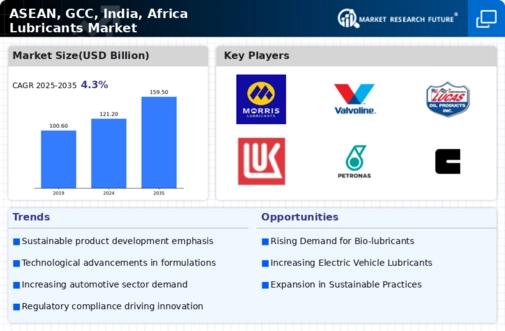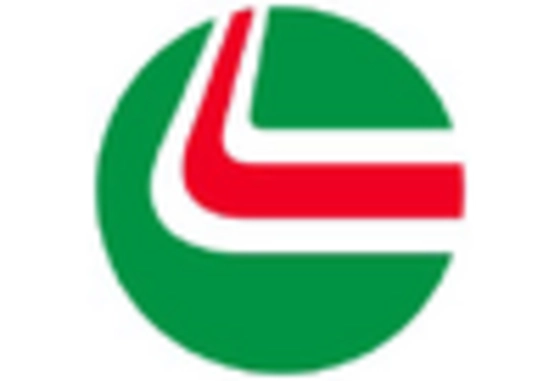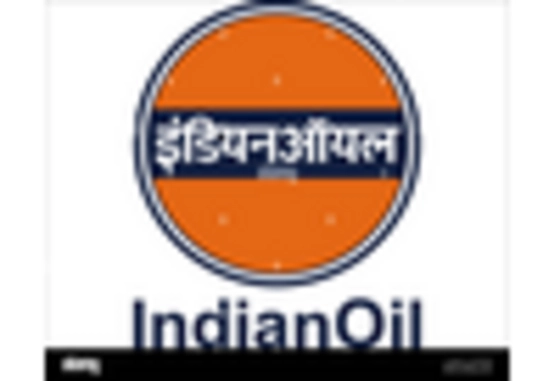Rising Automotive Production
The ASEAN, GCC, India, Africa Lubricants Market is experiencing a notable surge in automotive production, driven by increasing consumer demand for vehicles. In ASEAN, the automotive sector is projected to grow at a compound annual growth rate of approximately 6.5% from 2023 to 2028. This growth is likely to enhance the demand for lubricants, as vehicles require high-quality lubricants for optimal performance. Similarly, in India, the automotive industry is expected to reach a market size of USD 300 billion by 2026, further propelling lubricant consumption. The GCC region, with its focus on diversifying economies, is also witnessing a rise in automotive manufacturing, which could lead to increased lubricant sales. Consequently, the rising automotive production across these regions is a significant driver for the lubricants market.
Increasing Demand for Renewable Energy
The ASEAN, GCC, India, Africa Lubricants Market is witnessing a shift towards renewable energy sources, which is influencing lubricant demand. As countries in these regions invest in renewable energy projects, such as wind and solar, there is a growing need for specialized lubricants that can withstand unique operational conditions. For instance, the GCC is focusing on diversifying its energy sources, with investments in solar energy expected to reach USD 200 billion by 2030. This transition may lead to the development of new lubricant formulations tailored for renewable energy applications. In India, the government aims to achieve 175 GW of renewable energy capacity by 2022, which could further drive the demand for innovative lubrication solutions. Thus, the increasing emphasis on renewable energy is a pivotal driver for the lubricants market.
Technological Innovations in Lubrication
The ASEAN, GCC, India, Africa Lubricants Market is benefiting from rapid technological innovations in lubrication solutions. Advancements in formulation technology are leading to the development of high-performance lubricants that offer superior protection and efficiency. For instance, the introduction of nanotechnology in lubricant formulations is enhancing the performance characteristics of lubricants, making them more effective in extreme conditions. In India, the lubricant market is projected to grow at a CAGR of 4.5% from 2023 to 2028, driven by these technological advancements. Similarly, in the GCC, the adoption of smart lubrication systems is gaining traction, which could optimize lubricant usage and reduce waste. Therefore, technological innovations are likely to play a pivotal role in shaping the future of the lubricants market across these regions.
Industrial Growth and Infrastructure Development
The ASEAN, GCC, India, Africa Lubricants Market is significantly influenced by the ongoing industrial growth and infrastructure development initiatives. In India, the government has launched the National Infrastructure Pipeline, aiming to invest USD 1.4 trillion in infrastructure projects by 2025. This investment is expected to boost various industries, including manufacturing and construction, which are substantial consumers of lubricants. Similarly, in the GCC, the Vision 2030 initiative is driving infrastructure projects that require extensive lubrication solutions. ASEAN countries are also investing in infrastructure to enhance connectivity and trade, which could lead to increased lubricant demand. The industrial growth across these regions is likely to create a robust market for lubricants, as machinery and equipment require effective lubrication for efficiency and longevity.
Regulatory Compliance and Environmental Standards
The ASEAN, GCC, India, Africa Lubricants Market is increasingly shaped by stringent regulatory compliance and environmental standards. Governments in these regions are implementing regulations aimed at reducing emissions and promoting environmentally friendly products. For example, the European Union's REACH regulations are influencing lubricant formulations globally, including in ASEAN and GCC markets. In India, the Bureau of Indian Standards is setting guidelines for lubricant quality and environmental impact, which could lead to a shift towards bio-based and eco-friendly lubricants. As industries strive to meet these regulations, the demand for high-performance lubricants that comply with environmental standards is likely to rise. Consequently, regulatory compliance is a crucial driver for the lubricants market, pushing manufacturers to innovate and adapt their products.

















Leave a Comment